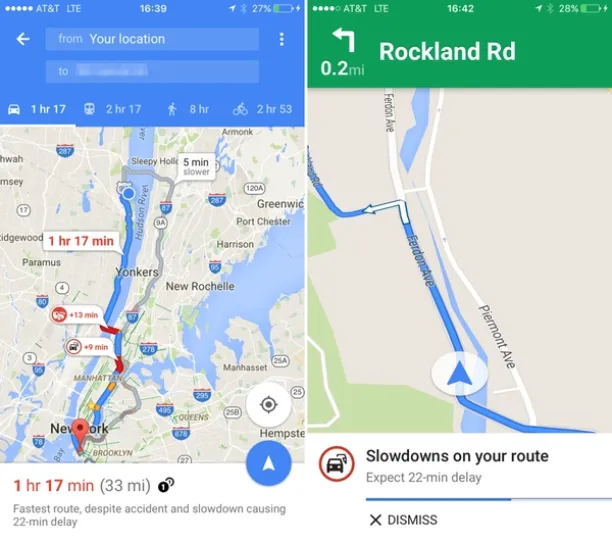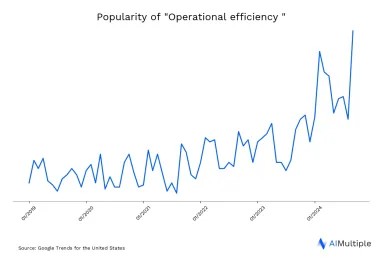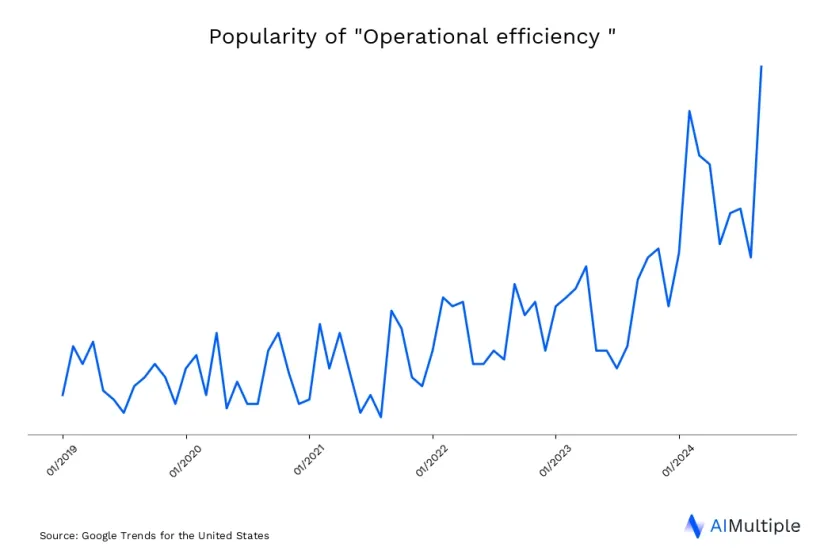The interest in operational efficiency has steadily been rising (Figure 1). That is because operational and process inefficiency can lead to:
- Wasted time: When business processes are inefficient, it takes longer to complete tasks, causing time wastage and lowering productivity. This can translate to missed deadlines and lost opportunities.
- Increased expenses: Inefficiencies raise costs because of subpar resource utilization and the consequent extra labor needed to finish the tasks.
- Poor quality: Inefficient processes can result in mistakes, errors, and rework, which can decrease the quality of the company’s products or services and damage its reputation.
- Reduced customer satisfaction: Delays, mistakes, and other problems caused by inefficient processes can hurt customer satisfaction and lead to lost business and money.
These negatives compel business leaders to look for ways to improve operational efficiency of their companies.
Explore 10 tools to improve operational efficiency within organizations. These tools are useful because they give an “as-is” picture of processes. Once you know what isn’t working, you can then take concrete measures to eliminate waste and increase your operational efficiency ratio.
1. Process mining
Process mining is a tool that leverages event log data to provide a comprehensive “as-is” look into your processes. The benefit of process mining is that it provides analysts with actionable insight to optimize processes and increase operational efficiency.
A manufacturer deployed process mining into their procure-to-pay (P2P) operations to discover and optimize the sub-processes. 1 With process mining, the firm was able to identify new automation opportunities, such as:
- Reducing lead times on line creation by 3 days (~$50,000 in savings),
- Automating 75% of delivery activities, thus reducing order reworking,
- Reducing association costs by ~$50,000.
Explore top process mining use cases, case studies, the latest stats and trends.
2. Digital twins & Digital twins of an organization (DTO)
Digital twins are virtual replicas of processes, products, or services. A specific use case of digital twins is replicating an organization’s workflows, through digital twins of an organization.
A DTO gives insight into the following factors:
- Past performance metrics
- KIPs
- Business goals, and more.
Google Maps, for instance, is a DT of the actual world (see Figure 2). It shows you the locations, the distance between two points, traffic density, and other points of interest related to cartography.
A use case of DTO is traffic management: The relevant ministries could leverage data from Google Maps to lower traffic flow by:
- Building roads on empty spaces,
- Increasing public transportation services in areas that have high traffic density,
- Figuring out why an area has more traffic than the other, and more.

Figure 2: Google Maps creates an easy-to-navigate representation of the actual world.2
Likewise, DTOs can create digital representations of firms, complete with personnel activities and procedures. Business executives can then get a complete picture of how their operations are running. DTOs also enables managers and analysts to run fictitious simulations on the models to examine potential real-world effects.
For example, Lehman Brothers generated and ran hypothetical, worst-case scenarios to stress test the resilience of their investment portfolios in order to get a sense of how exposed they are to market risks. 3 Generating digital twins for portfolios is still a common practice on Wall Street.
Explore more on Digital twin applications and DTO use cases in-detail.
3. Process diagnostics
Process diagnostics is a methodology that exposes bottlenecks in processes in a short time span by leveraging event logs. Process diagnostics, as the name suggests, provides a diagnosis for the remediation of a process.
A useful application of process diagnostics is automated root-cause analysis: whenever there’s a deviation from the norm, the software can list the reasons why that happened. More process mining vendors integrate automated root-cause analysis into their platform as a diagnostics capability.
A bread company 4 , for instance, saw production losses for various reasons, including:
- Toast packages being underweight
- Some toasts being burnt
- The toasts coming in different shapes and sizes
By using automated process diagnostics software, they were able to gain new insights into 138 processes. Furthermore, the root-cause analyses saved them over 1M euros in the production lines.
4. Process workflows
Process workflows are visualization of individual steps within a process (also called process mapping) by workflow management software applications. The benefit of this technology is that it can standardize processes by establishing the guidelines that have to be followed.
For instance, an American university 5 used workflow management software to establish an end-to-end framework for clarifying job requirements for professors, maintaining paperwork efficiently, and improving the onboarding process.
5. Process planning
Process planning’s real-life applications are mostly seen in manufacturing. A route sheet, for instance, is a byproduct of process planning that displays the step-by-step guide of how a product comes to be manufactured.
Through process planning, a route sheet is created, displaying the sequential steps of how a product is materialized. This allows companies to trace the steps back for analysis and optimization of how each step was carried out.
For instance, through process planning, a seat maker may discover that the most time is lost between the sewing of the cloth that covers the seat cushion and the latter’s placement on the seat. The manufacturer can identify this inefficiency and find remediation.
6. Process modeling
Process modeling could be considered a more advanced version of process mapping to increase operational efficiency: Instead of simply laying out the processes, you specify the details each process contains.
For instance, during modeling its business processes from the ground up, a bank was able to analyze the pain points and bottlenecks that were keeping its as-is processes bogged down in inefficiencies. Process modeling lowered the bank’s case duration from a claimed two-month to a couple of days.
7. Task mining
Task mining is the analysis of how individual tasks are done. Process mining vendors offer task mining capabilities to be installed on employees’ computers that record their interaction with an application and produce time snaps and screenshots.
The result could then show that, for instance, the customer representatives are spending the most time searching up invoices. This helps companies improve their operational efficiency by enabling the analysts to pinpoint their focus towards streamlining the invoice-lookup process.
8. Process improvement methodologies
Process improvement methodologies exist for specific use cases that might benefit from optimization.
Total Quality Management (TQM), for instance, is a process improvement methodology focused on dedicating resources to ensure that the workers within all departments “continuously improve” their activities.
Agile is another software that is mostly used in the manufacturing and construction sector that focuses on employees’ feedback to improve the processes.
But process improvement methodologies, as a whole, have been seeing decreasing popularity since the 2000s as they have been sidestepped by more holistic tools and approaches, such as process mining. Nevertheless, we have an article that discusses how you can pair methodology with technology to get the best results if you are interested in this framework.
9. RPA
RPA is the technology that lets robots do some tasks that humans usually do. In-office environments, where repetitive and mundane tasks can prevent employees from tending to more value-driven tasks, RPA can be leveraged to sidestep that challenge. RPA benefits can improve operational efficiency by:
- Increasing the speed at which tasks are done,
- Reducing the likelihood of manual errors,
- Starting workflows and processes on schedule,
- Being cost-efficient and allowing the saved money to be better spent elsewhere.
Read more about the robotic process automation use cases and how RPA can help companies reach operational excellence.
10. Business process management
Business process management (BPM) are methods, usually packaged in BPM software, that aim to optimize and improve business processes to serve strategic purposes.
Read more on the benefits of business process management (BPM) in more detail.
There are 5 stages of process management:
- Analyzing: Processes are analyzed and performance metrics are established
- Designing: An appropriate model is designed and chosen to improve on said-metrics
- Implementing: Through retraining staff, reallocating resources, and leveraging suitable solutions, the new model is implemented.
- Monitoring: The process gets up and running, with the analysts keeping an eye on the performance data.
- Optimizing: The data gathered from the previous step can fuel actionable insights to fine-tune the new process.
For more on process improvement
If you are interested in learning more about process improvement, read:
- 45 Process mining case studies & project results
- 6 Ways Process Mining Enhances Compliance
- Process Mining vs. Process Modeling: Which one to choose?
And if you believe your business would benefit from adopting a process mining solution, we have a data-driven list of vendors.
External Links
- 1. Global Manufacturing Company | IBM.
- 2. How Google Maps Knows About Traffic - Business Insider. Business Insider
- 3. “Risk Management Division.” Lehman Brothers Inc. September 2007. Revisited January 16, 2023.
- 4. “Reducing Quality & Waste Losses by 70% With Automated Root Cause Analysis.“SEEBO. Revisited January 16, 2023.
- 5. Michigan State University boosts collaboration & morale - Nintex. Nintex



Comments
Your email address will not be published. All fields are required.